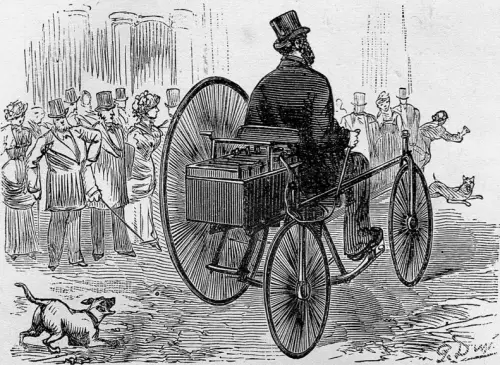Thomas Davenport Makes the First Electric Car in America in 1834 – New England Historical Society
Today’s makers of electric cars should tip their hats to Thomas Davenport of Forest Dale in Central Vermont. He made the first electric car in America in 1834.
Davenport, born in 1802, worked as a blacksmith. His poor father died when he was very young, and he was apprenticed into the trade as a boy. Thus he received little formal education, but he had an inquiring mind.

Davenport became interested in electromagnetics after learning about a machine based on the principles of electromagnetics to separate iron ore. He bought one of the devices and, in the time-honored tradition of tinkerers everywhere, he immediately took it apart. Davenport then built his own electromagnets.
Scientists working in the lab had demonstrated the principles behind the electric motor, but Davenport took the science from the lab and put it into practice in the real world. With help from his brother and his wife, he built his own batteries, step by step, and then a motor that ran on direct current.
The First Electric Car
His wife cut her wedding dress into strips of cloth so Davenport could use them to insulate the wires of his new motor. Professors from nearby Middlebury College helped encourage his work, along with others from Vermont and upstate New York.

With his motor working, he then had to launch a long battle with the U.S. Patent Office to patent the device. The government had never given a patent on an electrical device before.
Davenport had to gather testimonials from scientists who saw his machine work attesting to its originality. Finally, with his patent in hand in 1837, Davenport began looking for buyers. He installed his motor in a small train that operated on his property. Then in 1840 he used it to print The Electro-Magnetic and Mechanics Intelligencer, the first printing press run by an electric motor.

He invented the first electric car, which ran on a small track. It served as a prototype for the electric streetcar decades later.
Davenport wanted his electric motor to replace steam-powered locomotives. But batteries were unreliable, and he could not persuade people of the advantages of his DC motor.
Finally, Recognition
For the rest of his life Davenport would try in vain to find customers for his new, high-tech motor. His device was so unusual that people could not imagine the practical uses for it. He died in 1851 at age 48, dead broke.
In 1910, the National Electric Light Association finally recognized the genius behind his inventions. Accompanied by a brass band from nearby Brandon, an audience of 500 gathered to celebrate Davenport’s achievement and unveil a stone tablet commemorating it.

In a speech unveiling the tablet, Thomas Commerford Martin of the National Electric Light Association noted: “If the Davenport patent were enforced today it would embrace every one of the millions of electric motors in use in the United States, whose royalties would constitute an income equal to anything enjoyed by Carnegie or Rockefeller. It would have been a merciful dispensation if the bitter bread of struggle and disaster eaten all the years of his life by this extraordinary genius, this prophetic village blacksmith, could have been sweetened with the merest modicum of the vast wealth that his glowing conceptions have helped create for the benefit of us all.”
This story about the first electric car was updated in 2022.
Images: Thomas Davenport By Unknown author – http://www.granger.com/pix/POR1/D46/0082659_T.JPG, Public Domain, https://commons.wikimedia.org/w/index.php?curid=4726537. Blodgett’s Hotel, Washington, D.C. Washington D.C, None. [Between 1860 and 1880] [Photograph] Retrieved from the Library of Congress, https://www.loc.gov/item/2004678753/. Thomas Commerford Martin By Internet Archive Book Images – https://www.flickr.com/photos/internetarchivebookimages/14782177042/Source book page: https://archive.org/stream/pacificgaselectr61915paci/pacificgaselectr61915paci#page/n501/mode/1up, No restrictions, https://commons.wikimedia.org/w/index.php?curid=43319669. Gustave Trouve’s EV By Jacques CATTELIN – http://academie-de-touraine.com/Tome_25_files/067-092.pdf (Bibliothèque Nationale de France), CC BY-SA 4.0, https://commons.wikimedia.org/w/index.php?curid=52267675. Modern electric car By Michael Movchin / Felix Müller, CC BY-SA 3.0, https://commons.wikimedia.org/w/index.php?curid=27783265















![Toni Kroos là ai? [ sự thật về tiểu sử đầy đủ Toni Kroos ]](https://evbn.org/wp-content/uploads/New-Project-6635-1671934592.jpg)


